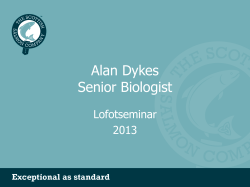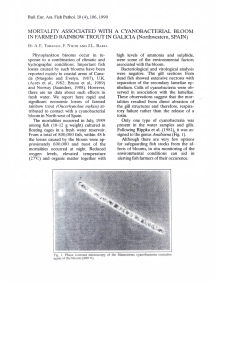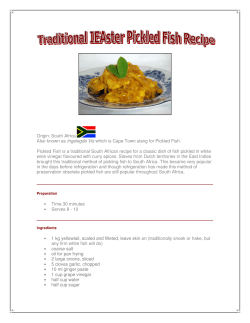
View Full Article - PDF - Global Science Research Journals
ISSN: 2408-5464 Vol. 3 (2), pp. 198-204, May, 2015. © Global Science Research Journals http://www.globalscienceresearchjournals.org/ Global Journal of Fisheries and Aquaculture Full Length Research Paper Re-stocking' model of snakehead farming, Channa striata blkr in the swamp bangkau of South Kalimantan Province Untung Bijaksana1, Hidayaturrahmah2, Dan Dewi Kartika Sari3 Departement of Aquaculture, Faculty of Fisheries and Marine Lambung Mangkurat University1 Departement of Biologi MIPA Lambung Mangkurat University2 Departement of Fishery Product Technology Lambung Mangkurat University3 Accepted 7 May, 2015 Abstract Snakehead, Channa striata Blkr is one of the freshwater commodities with high economicvalue. While meeting the needs of this largely still based on the fish catch in the wild. From the results of research in the last 5 years seen fish reproduction snakehead pattern can be used as a basis for the application of the "Re-Stocking". The fish used is snakehead caught in the wild, 30 individuals were taken as samples, each month for further observations on some reproductive indicators such as body weight, gonad weight, liver weight, gonado somatic index, somatic hevato index, egg diameter, fecundity and estradiol-17β. The results of recent research findings from March to July 2014, that the body weight of 210 grams to 220 grams per fish, gonad weight of 5.5 grams to 7.0 grams per fish, liver weight from 1.5 grams to 1.9 grams per head, Gonado somatic index of 2.62% until 3:18 %, hevato somatic index of 0.71% to 0.86%, egg diameter 0.9 mm to 1.3 mm, the fecundity of 3025 points to 3105 points and E2 of 90 pg / ml to 125 pg / ml. From these results it can be concluded that at the peak of the dry season, snakehead will be at the end of the maturity level. At the time of arrest should be selected based on the "size", to be manipulation that can spawn in the container cultivation. For the next "seed" obtained stocked back into natural waters. Keywords: Snakehead, Channa striata, swamp waters, re-stocking INTRODUCTION South Kalimantan Province has the potential for 80.790 hectares of open water where the swamp area covering 60.697 hectares and an area of 20.093 hectares of the river. Potential waters of the swamp in South Hulu Sungai area of 60 697 hectares, most of the area is used as a fishing effort. In 2011 the potential of fishery resources in the waters of Upper South River district general at 23.737 Ton / Year. Corresponding author. Email: bijaksanau@yahoo.co.id Efforts to do so is the management and utilization of biological resources potential in the swamp waters may be optimal and sustainable. Especially for local fish can be done in stages to the development of the local fish perfectly domesticated. Expected to be an alternative to commodity farming. Snakehead (Channa striataBlkr) is one of the swamp fish which has the ability to tolerate low water environmental conditions. Although the maintenance effort has begun to evolve, but it is still highly dependent on seed catches in nature. For the people of Banjar or Melayu tribe or ethnic Malays, this fish can be called "iwak budaya", in addition to a very popular also has a high economic value Glob. J. Fish. Aquac. 199 Figure 1: Results of Measurement of Body Weight Snakehead in Water Swamp Bangkau Price per kilogram of fresh fish outside snakeheading season and in the current 75.000,0 USD fishing season per kilogram 35.000,0 USD. In the form of processed (dried fish) in the off-season 100.000,0 USD per kilogram and in the fishing season 60.000,0 USD per kilogram. Especially for the people of Borneo, where snacks "ketupat kandangan" is not complete when the side dishes not use a snakehead. Dependence "flavor" makes selling value and bargaining power so high for these commodity. Because such a powerful ontology in addition to the function snakehead as one of the wounded healer is very effective in containing albumin rightly done domestication efforts. MATERIALS AND METHODS This study was conducted descriptively. Data collection was performed every 15 days. A total of 30 individuals weighing ± 200 g / fish, were sampled. The fish used is female snakehead with the observation weight, gonad weight, liver weight, IGS, IHS, estradiol-17β, egg diameter, and fecundity. The content of estradiol-17β and cortisol were measured by ELISA, egg diameter was measured by taking a sample of eggs by means of surgery. The eggs were taken, fixed in buffered formalin solution. Furthermore, the frequency distribution of the diameter of the eggs is made (Tamaru et al. 1991). Measurement of gonado somatic index (IGS) is then performed by surgery weighing gonads compared with body weight and hevato somatic index (IHS), comparing heart weight with body weight. For eliminating the stress of the test fish anesthetized with a solution of 100 ppm banzocaine. Blood samples at a speed of 5000 rpm disentrifius for 5-10 minutes. The supernatant was taken and stored at -20 ° C, pending measurement of Radio Immuno Assay (Liley & Rouger 1990; Zanuy et al., 1999). RESULTS AND DISCUSSION Body’s Weight The results of measurements of snakehead body weight caught in waters swamp Bangkau Hulu Sungai Selatan, South Kalimantan Province from March to August ranged from 210 grams in March to 225 grams in August. At this time the reproductive growth occurs when the gonad weight of fish associated with cork. According to Bijaksana (2006) that the snakehead in natural waters will spawn at the start of the rainy season. Under these conditions, obtained correspondence between the state of the relationship with weight gain season snakehead, allegations of 2-3 months ahead of the rainy season is a stimulus in the development of snakehead reproduction in natural waters. When the peak of the dry season, generally there will be a decrease in body weight of snakehead (Bijaksana, 2009). State and a decrease in body weight gain was related to food availability. Lack of food snakehead in the top of the dry season, making this fish convert most of its energy to the Final Oocytes Maturation. The results of measurements of body weight snakehead caught in waters swamp Bangkau is presented in Figure 1. Gonad’s Weight The results of measurements of gonad’s weight of snakehead in the waters swamp Bangkau from March to July ranged from 5.5 gram in March to 7.2 grams in August. Weight of gonad’s snakehead gain is the data that supports the development of the gonads and gonads of fish or maturity level to the final Oocytes Maturation in the beginning of the rainy season. In fish reproduction there are 2 main things is important, namely: 1) the Bijaksana et al. 200 Figure 2: Results of the Snakehead Gonad Weight Measurement in Water Swamp Bangkau Figure 3: Results of the Snakehead’s Liver Weight Measurement in Water Swamp Bangkau development of gonad maturity, 2) the process of ovulation and spawning. When linked with the level of maturity of gonads, the gonads of snakehead caught are in phase III development. The results of measurements of gonad weight of snakehead caught in waters swamp Bangkau is presented in Figure 2. Liver’s Weight The results of measurements of snakehead liver weights in the waters of the swamp Bangkau from March to July ranged from 1.5 gram in March to 2.0 grams in August. Liver weight gain is in line with the gonad weight gain or levels of gonad’s Maturity means supporting the weight of the liver is the energy in gonad development of fish in the waters of the swamp Bangkau. This is in accordance with what was stated (Bijaksana et al., 2009) that there is a linear relationship between the weight of the gonads with snakehead’s liver weights in both and natural waters in the container cultivation. When reproductive growth occur, in general somatic growth will be stagnant, even declining in the late developmental maturity level. The role and function of the liver is so great as an energy source. The results of measurements of liver weights of snakehead caught in presented in Figure 3. waters swamp Bangkau is Gonado Somatic Index (IGS) The results of the analysis showed that gonado somatic index in March of 2.62 to 3.2 in August. In such figures gonads Maturity Levels are at level III-IV. In 2-3 months ahead will be the rainy season, the level of maturity of gonads will be at level IV. In the fish already in the gonad maturity level IV, will experience a phase of "dormant", it means waiting for a trigger or signal environment. Physiologically ripe eggs. Will naturally occur snakehead spawning season. Naturally spawning fish cork still waiting for the signal means is still awaiting environmental alternation of seasons. The results of the analysis Gonado Somatic Index snakehead caught in the waters of the swamp Bangkau is presented in Figure 4. According to Utomo et al. (1992) catfish and other fish species in the waters of the swamp doing spawning at the beginning or in the middle of the rainy season. Furthermore, according to Kartamihardja (1994), catfish spawn in reservoirs Kedongombo with a ratio of 1:1, of the 24 individuals with a total length range between 18.5 Glob. J. Fish. Aquac. 201 Figure 4: Results Analysis IGS Snakehead in Water Swamp Bangkau Figure 5: Results of Analysis IHS Water Swamp Fish Cork in Bangkau to 50.5 cm, weight range from 60 to 1,020 g, and gonad weight range between 2.70 to 16:02 g obtained fecundity eggs as 2585 to 12 880 grains. Hevato Somatic Index The results of the analysis showed that hevato somatic index in March was 0.71 and of 0.88 in August. Bijaksana et al., (2009) suggested that the larger the index value hevato somatic snakehead, is a guarantee of the development of gonado somatic index. Supporting great energy characterized by the value hevato somatic index. Availability of food in the waters of the swamp environment is a factor that play a central role. Reproductive parameter values are linearly related to the persistence of the rain. If the season is quite different between rainy season and dry season, usually obtained greater value again. The results of the analysis hevato somatic index snakehead caught in the waters of the swamp Bangkau is presented in Figure 5. -17 β Estradiol (E2) Results of Estradiol-17 β measurements showed that in March of 90 pg / ml and in August amounted to 140 pg / ml. Synthesis vitelogenin (yolk precursor) in the liver is called vitellogenesis. Vitelogenin transported into the blood to the oocyte, then selectively absorbed and stored as yolk. This Vitelogenin glikofosfoprotein form which contains about 20% fat, primarily phospholipids, triglycerides and cholesterol. Vitelogenin molecular weight for several species of fish are known between 140-220 kDa (Tyler 1991; Komatsu and Hayashi 1997). Some research shows that increasing concentrations of estradiol-17β, may increase the concentration of blood vitelogenin. This suggests that changes in the concentration of estradiol-17β in fish blood vitelogenin line with changes in the concentration of blood, so it can provide an indication that 17β estradiol, are responsible for the synthesis of vitellogenin. In females, the ovaries respond to increased concentrations of gonadotropins by indirectly increasing the production of estrogen is estradiol-17β. Estradiol-17β circulated to the liver, enter the network by means of diffusion and specifically stimulates the synthesis vitelogenin (Ng & Idler 1983). Androgens can also stimulate vitellogenesis, it is possible to convert androgens to estrogens. This vitelogenesis activity causes hepatosomatic index value (IHS) and gonadosomatic index (IGS) fish increased (Schulzt 1984; Cerda et al. 1996). Oocyte development is caused by the Bijaksana et al. 202 Figure 6: Measurement results of Snakehead’s Estradiol-17β concentrations in waters Swamp Bangkau Figure 7: Results of Measurement Egg Diameter of Snakehead in Water Swamp Bangkau accumulation of yolk. There are three types of yolk material in fish Teleostei, ie small grain oils, bubble egg yolk and egg yolk granules. The phenomenon of accumulation of yolk material by fish oocyte is divided into two phases, namely the synthesis of egg yolk in the oocyte or "vitelogenesis endogenous" and the accumulation of yolk precursors are synthesized outside the oocyte or "vitelogenesis exogenous" (Matty 1985). The results of measurements of the concentration of estradiol-17β snakehead caught in the waters of the swamp Bangkau is presented in Figure 6. Diameter Eggs Measurement of the diameter of the eggs in the gonads mature aims to estimate spawning frequency, ie the egg mass deployment mode. The fertilized eggs float on the foam with a diameter of about 1.0 mm (Bijaksana, 2006). While the snakehead’s egg diameter on the Mekong River at TKG IV is 0:20 - 1.6 mm (Long et al., 2002). Furthermore Fitriliyani (2005) suggested that snakehead in Lake Roast South Kalimantan,has a diameter of eggs between 1:00 mm to 1.60 mm. The results of measurements of the diameter of the eggs of snakehead in the waters of the swamp Bangkau from March to July ranged from 0.9 mm in March to 1.5 mm in August. Egg size or diameter of the eggs may be an indicator of the level of maturity. In a difficult fish spawn in the cultivation of the diameter of the egg container is that it can be the clue. Prior to spawning (merging male and female), usually performed cannulation urogenital fish. Homogeneous egg diameter indicates that the spawning pattern is a total spawner and when heterogeneous usually partial spawner. Based on the diameter of the snakehead eggs can spawn 2-3 times in a season nurseries. The maximum size of snakehead’s eggs diameter is 1.5 mm and a minimum of 0.4 mm (Bijaksana, 2010). The results of measurements of the diameter of the eggs of snakehead caught in waters swamp Bangkau is presented in Figure 7. Fecundity The results of the calculation of fecundity in snakehead Bangkau swamp waters from March to July 3025 ranged between grains in March to 3130 points in August. Fecundity associated with the diameter of the egg. Diameter snakehead eggs large enough around 1.5 mm with a size of about 5,000 so then fecundity points to 6,500 points for body weight of about 400 g / head. The results of the calculation of fecundity catfish caught in the wamp waters Bangkau is presented in Figure 8. Glob. J. Fish. Aquac. 203 Table 1: Results of Multiple Parameter Measurement of Snakehead Reproduction PARAMETERS BODY’S WEIGHT (gr) GONAD’S WEIGHT (gr) LIVER’S WEIGHT (gr) IGS (%) HIS (%) E2 (pg/ml) EGG’S DIAMETER FECUNDITY MONTH MARCH 210 ± 5 APRIL 212 ± 4 MAY 214 ± 5 JUNE 215 ± 4 JULY 220 ± 3 AUGUST 225 ± 3 5.5 ± 5 6.0 ± 5 6.5 ± 5 6.8 ± 4 7.0 ± 5 7.2 ± 5 1.5 ± 0.05 1.6 ±0.05 1.7 ± 0.05 1.8 ± 0.05 1.9 ± 0.05 2.0 ± 0.05 2.62 0.71 90 ± 5 0.9 ± 0.5 3025 ± 5 2.83 0.75 95 ± 5 1.0 ± 0.6 3050 ± 5 3.03 0.79 100 ± 5 1.2 ± 0.5 3070 ± 5 3.16 0.83 110 ± 5 1.2 ± 0.5 3085 ± 8 3.18 0,86 125 ± 5 1.3 ± 0.4 3105 ± 10 3.2 0,88 140 ± 5 1.5 ± 0.3 3130 ± 10 Table 2: Results of the analysis of the digestive tract holding of snakehead in the period of gonadal maturation FOOD TYPE Small Fish Crustacea Etc MONTH MARCH 40 % 35 % 25% 100 % APRIL 40 % 40 % 20% 100 % MAY 40 % 45 % 15% 100 % JUNE 35 % 50 % 15 % 100 % JULY 30 % 50 % 20 % 100 % AUGUST 15 % 60 % 25 % 100 % Figure 8: Calculation results fecundity Snakehead in Water Swamp Bangkau Food that is eaten type of snakehead holding in gonadal maturation period, can be grouped in 3 main food types, namely: a group of small fish, crustaceans and other types. In Table 2 are presented the results of the analysis of the digestive tract of snakehead. Snakehead is a species of freshwater fish and the fish are able to eat a variety of foods such as Artemia nauplii consuming larval phase (Jianguang et al., 1997; Ng & Lim 1990), Daphnia and Cyclops, while adult fish eat shrimp, insects, frogs, worms and small fish (Fitriliani, 2005). Based on data from snakehead reproductive parameters that the maturity level of gonadal development leading to the final maturity level. When linked with the 'season' the September-October, will occur in the spawning season Bangkau swamp waters. At the time in the month of April-May, still it rains, it supports the results of analysis of snakehead digestive tract, ie small fish. In the dry season when the moon is closer to the feed available in natural waters are the kinds of crustacean. The availability of food in natural waters is supporting the development of snakehead gonad maturity level. At the peak of the dry season, where the 'water' has been very minimal, the catfish will survive with energy savings. In general, at the peak of the dry season, the weight of the snakehead’s body will decrease or smaller. CONCLUSION 1. Life cycle, in particular the patterns of reproduction snakehead, closely related to the season. Bijaksana et al. 204 2. The application of the model "re-stocking", for snakehead in the swamp waters with regard to his position as a fish "top carnivores". 3. The combination of hatchery technology applications with local knowledge is the guarantee sustainability in the region of potential genetics swamp waters. ACKNOWLEDGEMENT This study was fine shed by the Development and Upgrading of Seven Universities in Improving the Quality and Relevance of Higher Education in Indonesia REFERENCES Bijaksana U (2006). Studi pendahuluan bio-eko reproduksi snakehead di rawa Bangkau Propinsi Kalimantan Selatan. Simposium Nasional Bioteknologi dalam Akuakultur 2006. Departemen Budidaya Perairan Fakultas Perikanan dan Ilmu Kelautan Institut Pertanian Bogor dan Balai Riset Perikanan Budidaya Air Tawar Badan Riset Kelautan dan Perikanan. 5 Juli 2006. Bijaksana U, M Zairin Junior, D Djoko Setiyanto, Iman Supriatna dan Djadja S Sjafe’i (2009). Pengaruh pemberian jenis pakan yang berbeda terhadap kematangan gonad ikan gabus, Channa striata Blkr dalam wadah budidaya. Pusat Penelitian Limnologi. Lembaga Ilmu Pengetahuan Indonesia. LIMNOTEK. Perairan Darat Tropis Di Indonesia. Volume XVI. Hal 47-55. Bijaksana U (2010). Status reproduksi ikan gabus, Channa striata Blkr, Simposium Nasional Bioteknologi dalam Akuakultur III Bogor. Prosiding ISBN : 987-602-97870-09. Fitriliyani I (2005). Pembesaran larva ikan gabus, Channa striata dan efektifitas induksi hormon gonadotropin untuk pemijahan induk. [tesis]. Bogor: Program Studi Biologi Reproduksi. Sekolah Pascasarjana. IPB. Jianguang Q, Fast AW, Kai AT. 1997. Tolerance of snakehead, Channa striatus to ammonia at different pH. JW Aqua Soc 28: 87-90. Komatsu M, Hayashi S (1997). Pharmacological dose of estradiol 17β induces vitellogenin synthesis in cultured hepatocytes of immature Eel Anguilla japonica. Fish Scie 63(6): 989-994. Liley NR, Rouger Y (1990). Plasma levels of gonadotropin and 17β, 20β-hidroxy4-pregnen-3-one in relation to spawning behavior of rainbouw trout, Onchorynchzis mykiss (Walbaum). J Fish Biol 37: 699-711. Long DN, Nguyen VT, Lee ST (2002). Technical aspects for artificial propagation of snakehead, Ophiocephalus striatus in Mekong delta. Vietnam: Fisheries Sciences Institut Cantho University. Matty AJ (1985). Fish endocrinology. Portland: Timber Press. Ng TB, Idler DR (1983). Yolk formation and differentiation in teleost fishes. In: WS Hoar, DJ Randall and EM Donaldson (Eds). Fish physiology. Vol. IXA. New York: Academic Press. p: 373-404. Ng PKL, Lim KKP (1990). Snakeheads (pisces; Channidae): Natural history, biology and economic importance. Singapura: Departemen of Zoology, National University of Singapore. p: 127 – 152. Schulzt R (1984). Serum level of 11-ketotestosterone in male and 17βestradiol in female rainbow trout, Salmo gairdneri during the first reproductive cycle. Gen. Comp. Endocrinol. 56: 111-120. Tamaru CS, Kelley CD, Lee CS, Aida K, Hanyu I, Goetz F (1991). Steroid profiles during maturation and induced spawning of the striped mullet, Mugil cephalus L. Aquaculture, 95: 149-168. Tyler C (1991). Vitellogenesis in salmonid. In: A.P. Scott. J.P. Sumpter. D.E. Kinne and M.S. Rolfe (Eds). Proceedinghs of The Fourth International Symposium on The Reproductive Physiology of Fish. University of East Auglia. Norwich. p: 295-299. Utomo AD, Nasution Z, Adie S (1992). Kondisi ekologi dan potensi sumberdaya perikanan sungai dan rawa. Temu Karya Ilmiah Perikanan Perairan Umum. Jakarta. Puslitbang Perikanan. Badan Litbang Pertanian. Departemen Pertanian. Zanuy S, Carrillo M, Mateos J, Trudeau V, Kah O (1999). Effect of sustained administration of testosterone in pre-pubertal sea bass, Dicentrachiis labrax L). Aquaculture, 177: 21-35
© Copyright 2025









